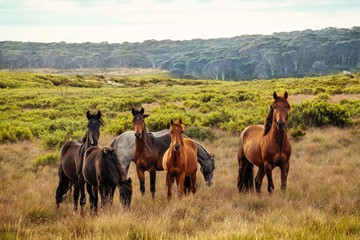The Invasive Species Council welcomes the Victorian Supreme Court’s decision to protect the Alpine National Park from growing horse impacts but is concerned the possibility of further legal action will delay the inevitable.
“Bogong High Plains is at risk of becoming ‘Bogong Horse Plains’ if there continues to be delays in Parks Victoria’s implementation of their feral horse removal plan,” said Invasive Species Council CEO Andrew Cox.
>> Images of Bogong High Plains, native species and horse damage
“Bushland trying to regenerate after the devastating summer bushfires needs relief and has been under pressure from grazing and trampling by introduced animals.
“We thank the ongoing dedication and professionalism of Parks Victoria staff for protecting Victoria’s national parks from one of the most damaging feral herbivores to invade the Alpine National Park since the rabbit plague.
“There are an estimated 100 feral horses in the Bogong High Plains, and the eastern Victorian Alps, with around 5000 horses, are being severely impacted by feral horses.
“Horse numbers in both the Victorian and NSW Alps have more than doubled in the past five years.
“Horse control needs to commence urgently, alongside existing deer, pig and goat control programs that have already been underway since January.”
ANU Professor Jamie Pittock said claims these operations cause severe suffering and constitute ‘senseless slaughter’ are baseless.
“All pest control programs are undertaken according to strict animal welfare protocols. Measures involving horse control benefit from additional vet supervision.
“Like many pest control programs, achieving a permanent reduction in horse populations will be a slow and arduous task,” he said.
“We’re pleased trapping and rehoming remains a priority, but to achieve horse population reduction other control measures will be needed.”
The case, lodged in the Supreme Court on Tuesday, sought to stop the planned removal of feral horses from the Alpine National Park based on claims there was a lack of public consultation.
The case was thrown out because the applicant had no standing, but Parks Victoria have volunteered to delay implementation of its plan to allow the applicant to lodge an appeal.
“It is ironic that those seeking to protect the horses today are claiming to represent the traditions of people that chased, rounded up, trapped and killed hundreds of horses,” Professor Pittock said.
“The horses are trampling the alpine bogs, destroying the habitat of threatened plants and animals such as the broad-toothed rat and alpine she-oak lizard and damaging Indigenous sites.
“All of the Bogong High Plains horses and some of those in the Eastern Alps are planned to be removed over the next few years.
“There’s now been two court rulings in Parks Victoria’s favour, when will they be able to get on with their job of protecting the park?” Professor Pittock said.
“As Banjo Patterson wrote, ‘if they didn’t get rid of the horses the horses would get rid of them.’”









